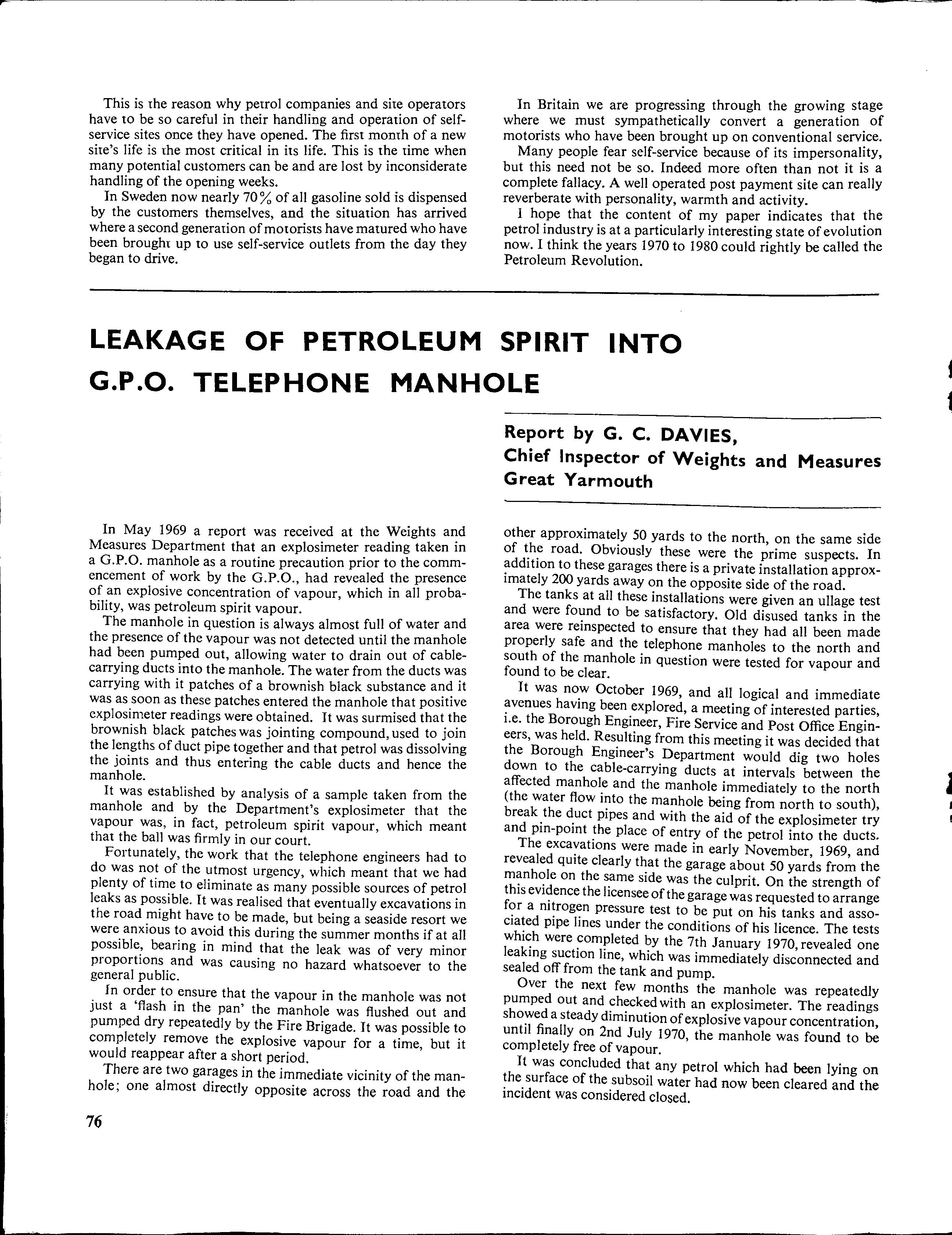
4 minute read
Leakage of Petroleum Spirit
This is the reason why petrol companies and site operators have to be so careful in their handling and operation of selfservice sites once they have opened. The first month of a new site's life is the most critical in its life. This is the time when many potential customers can be and are lost by inconsiderate handling of the opening weeks.
In Sweden now nearly 70 % of all gasoline sold is dispensed by the customers themselves, and the situation has arrived where a second generation of motorists have matured who have been brought up to use self-service outlets from the day they began to drive.
Advertisement
In Britain we are progressing through the growing stage where we must sympathetically convert a generation of motorists who have been brought up on conventional service.
Many people fear self-service because of its impersonality, but this need not be so. Indeed more often than not it is a complete fallacy. A well operated post payment site can really reverberate with personality, warmth and activity.
I hope that the content of my paper indicates that the petrol industry is at a particularly interesting state of evolution now. I think the years 1970 to 1980 could rightly be called the Petroleum Revolution.
LEAKAGE OF PETROLEUM SPIRIT INTO G.P.O. TELEPHONE MANHOLE
Report by G. C. DAVIES, Chief Inspector of Weights and Measures Great Yarmouth
In May 1969 a report was received at the Weights and Measures Department that an explosimeter reading taken in a G.P.O. manhole as a routine precaution prior to the commencement of work by the G.P.O., had revealed the presence of an explosive concentration of vapour, which in all probability, was petroleum spirit vapour.
The manhole in question is always almost full of water and the presence of the vapour was not detected until the manhole had been pumped out, allowing water to drain out of cablecarrying ducts into the manhole. The water from the ducts was carrying with it patches of a brownish black substance and it was as soon as these patches entered the manhole that positive explosimeter readings were obtained. It was surmised that the brownish black patches was jointing compound, used to join the lengths of duct pipe together and that petrol was dissolving the joints and thus entering the cable ducts and hence the manhole.
It was established by analysis of a sample taken from the manhole and by the Department's explosimeter that the vapour was, in fact, petroleum spirit vapour, which meant that the ball was firmly in our court.
Fortunately, the work that the telephone engineers had to do was not of the utmost urgency, which meant that we had plenty of time to eliminate as many possible sources of petrol leaks as possible. It was realised that eventually excavations in the road might have to be made, but being a seaside resort we were anxious to avoid this during the summer months if at all possible, bearing in mind that the leak was of very minor proportions and was causing no hazard whatsoever to the general public.
In order to ensure that the vapour in the manhole was not just a 'flash in the pan' the manhole was flushed out and pumped dry repeatedly by the Fire Brigade. It was possible to completely remove the explosive vapour for a time, but it would reappear after a short period.
There are two garages in the immediate vicinity of the manhole; one almost directly opposite across the road and the
76
other approximately 50 yards to the north, on the same side of the road. Obviously these were the prime suspects. In addition to these garages there is a private installation approximately 200 yards away on the opposite side of the road.
The tanks at all these installations were given an ullage test and were found to be satisfactory. Old disused tanks in the area were reinspected to ensure that they had all been made properly safe and the telephone manholes to the north and south of the manhole in question were tested for vapour and found to be clear.
It was now October 1969, and all logical and immediate avenues having been explored, a meeting of interested parties, i.e. the Borough Engineer, Fire Service and Post Office Engineers, was held. Resulting from this meeting it was decided that the Borough Engineer's Department would dig two holes down to the cable-carrying ducts at intervals between the affected manhole and the manhole immediately to the north (the water flow into the manhole being from north to south), break the duct pipes and with the aid of the explosimeter try and pin-point the place of entry of the petrol into the ducts.
The excavations were made in early November, 1969, and revealed quite clearly that the garage about 50 yards from the manhole on the same side was the culprit. On the strength of this evidence the licensee of the garage was requested to arrange for a nitrogen pressure test to be put on his tanks and associated pipe lines under the conditions of his licence. The tests were completed by the 7th January 1970,revealed one leakmg suction line, which was immediately disconnected and sealed off from the tank and pump.
Over the next few months the manhole was repeatedly pumped out and checked with an explosimeter. The readings showed a steady diminution of explosive vapour concentration, until finally on 2nd July 1970, the manhole was found to be completely free of vapour.
It was concluded that any petrol which had been lying on the surface of the subsoil water had now been cleared and the incident was considered closed.










